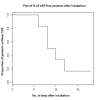Incidence, Risk Factors, and Mortality From Hospital-Acquired Infections at a Hospital in Mauritius
- PMID: 34976541
- PMCID: PMC8713534
- DOI: 10.7759/cureus.19962
Incidence, Risk Factors, and Mortality From Hospital-Acquired Infections at a Hospital in Mauritius
Abstract
Introduction Hospital-acquired infections can be associated with an increase in morbidity, length of stay, and cost. Data on this topic are very limited in Mauritius. This study seeks to identify (a) the most prevalent hospital-acquired infection locally, (b) the risk factors for acquiring nosocomial infections, and (c) the mortality rate linked to such infections. Methods This is an observational study that was conducted at a 600-bed hospital in Mauritius by going through the folders of 109 patients who were admitted in different wards. Cox regression was used to carry out the survival analysis. Results Over the past 25 years, the incidence of hospital-acquired infections has increased by two to three times in Mauritius to reach a value of 18 per 100 admitted patients. The most commonly identified nosocomial infection was ventilator-associated pneumonia. The presence of foreign devices increased the risk of acquiring nosocomial infections. The mortality rate from such infections was almost four times higher compared to the mortality rate from patients who did not suffer from these infections; however, after adjustment for potential confounders, this was not statistically significant. The incidence of ventilator-associated pneumonia and central line-associated bloodstream infections was high at 46 per 1,000 ventilator-days and 25 per 1,000 central line days, respectively. Conclusion Infection prevention and control measures should be implemented to curtail the rise of hospital-acquired infections in Mauritius. Such measures should include the use of bundles of care. In addition, periodic surveillance of nosocomial infections needs to be encouraged.
Keywords: central line-associated bloodstream infections; hospital-acquired infections; nosocomial; surgical site infections; ventilator-associated pneumonia.
Copyright © 2021, Nuckchady et al.
Conflict of interest statement
The authors have declared that no competing interests exist.
Figures




Similar articles
-
Nosocomial infections in medical-surgical intensive care units in Argentina: attributable mortality and length of stay.Am J Infect Control. 2003 Aug;31(5):291-5. doi: 10.1067/mic.2003.1. Am J Infect Control. 2003. PMID: 12888765
-
Trauma severity scoring systems as predictors of nosocomial infection.Infect Control Hosp Epidemiol. 2002 May;23(5):268-73. doi: 10.1086/502047. Infect Control Hosp Epidemiol. 2002. PMID: 12026152
-
The national rate of intensive care units-acquired infections, one-year retrospective study in Iran.BMC Public Health. 2021 Mar 29;21(1):609. doi: 10.1186/s12889-021-10639-6. BMC Public Health. 2021. PMID: 33781227 Free PMC article.
-
The impact of nosocomial infections on patient outcomes following cardiac surgery.Chest. 1997 Sep;112(3):666-75. doi: 10.1378/chest.112.3.666. Chest. 1997. PMID: 9315799
-
[Evaluation of Infections in Intensive Care Units: A Multicentre Point-Prevalence Study].Mikrobiyol Bul. 2019 Oct;53(4):364-373. doi: 10.5578/mb.68665. Mikrobiyol Bul. 2019. PMID: 31709934 Review. Turkish.
Cited by
-
Probiotic prophylaxis to prevent ventilator-associated pneumonia in children on mechanical ventilation: A randomized double-blind clinical trial.Front Pediatr. 2022 Nov 15;10:1045941. doi: 10.3389/fped.2022.1045941. eCollection 2022. Front Pediatr. 2022. PMID: 36458140 Free PMC article.
-
Artificial Intelligence in Bacterial Infections Control: A Scoping Review.Antibiotics (Basel). 2025 Mar 2;14(3):256. doi: 10.3390/antibiotics14030256. Antibiotics (Basel). 2025. PMID: 40149067 Free PMC article. Review.
-
Point prevalence survey on antibiotic use in the hospitals of Mauritius.Front Antibiot. 2023 Jan 9;1:1045081. doi: 10.3389/frabi.2022.1045081. eCollection 2022. Front Antibiot. 2023. PMID: 39816406 Free PMC article.
-
Surveillance and Reporting of Hospital-Associated Infections-A Document Analysis of Romanian Healthcare Legislation Evolution over 20 Years.Healthcare (Basel). 2025 Jan 24;13(3):229. doi: 10.3390/healthcare13030229. Healthcare (Basel). 2025. PMID: 39942418 Free PMC article.
-
The value of the INFECTIONS scoring system in identifying bacterial infections among patients presenting at the emergency department of a middle-income country: A pilot study.Chin J Traumatol. 2024 Mar;27(2):77-82. doi: 10.1016/j.cjtee.2023.09.001. Epub 2023 Sep 4. Chin J Traumatol. 2024. PMID: 37690867 Free PMC article.
References
-
- Impact on morbidity, mortality, and length of stay of hospital-acquired infections by resistant microorganisms. Barrasa-Villar JI, Aibar-Remón C, Prieto-Andrés P, Mareca-Doñate R, Moliner-Lahoz J. Clin Infect Dis. 2017;65:644–652. - PubMed
-
- Estimation of extra length of stay attributable to hospital-acquired infections in adult ICUs using a time-dependent multistate model. Ohannessian R, Gustin MP, Bénet T, et al. Crit Care Med. 2018;46:1093–1098. - PubMed
-
- Prevalence of infections and use of antibiotics among hospitalized patients in Mauritius. A nationwide survey for the planning of a national infection control programme. Jepsen OB, Jensen LP, Zimakoff J, et al. J Hosp Infect. 1993;25:271–278. - PubMed
-
- The prevalence of multi-drug resistant organisms and their outcomes in an ICU in Mauritius: an observational study. Nuckchady DC, Boolaky SH. Asian J Med Health. 2020;21:71–78.
-
- Bloodstream Infection Event (Central Line-Associated Bloodstream Infection and Non-central Line Associated Bloodstream Infection) [ Jul; 2021 ];https://www.cdc.gov/nhsn/pdfs/pscmanual/4psc_clabscurrent.pdf 2021
LinkOut - more resources
Full Text Sources
Miscellaneous
